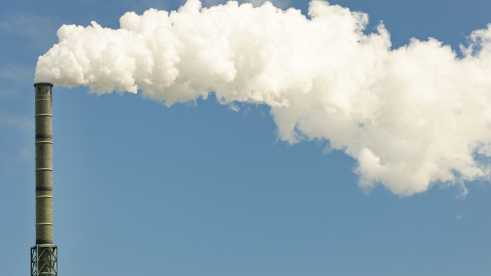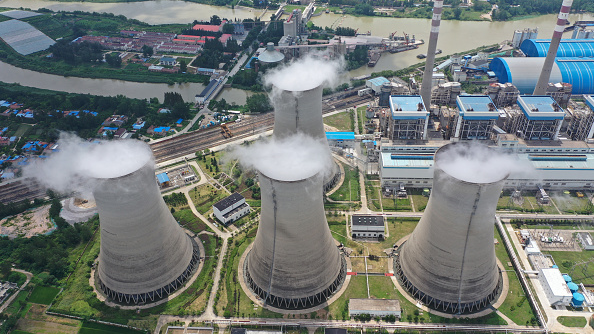
Editor's note: Cui Ying is the director of the Climate Finance Research Center at the International Institute of Green Finance, Central University of Finance and Economics. Zhou Jieyu is a research fellow at the International Institute of Green Finance, Central University of Finance and Economics. The article reflects the authors' opinions and not necessarily the views of CGTN.
On July 16, 2021, China's National Carbon Emissions Trading Market was officially launched.
As a market-based emission reduction tool, the carbon market can realize the optimal allocation of resources and guides emission control companies in their low-carbon transformation through price signals formed by the market. Compared with the administrative measures, the carbon market can help achieve the same amount of greenhouse gas emissions reduction at a lower cost.
The national carbon market is based on the rich experience accumulated in pilot carbon markets.
Since October 2011, China has successfully launched eight carbon pilot markets in Beijing, Shanghai, Tianjin, Chongqing, Hubei, Guangdong, Shenzhen, and Fujian. As of June 2021, the pilot carbon market has covered more than 20 industries and nearly 3,000 key emitting companies.
The national carbon market is more efficient than the pilot carbon market.
Liquidity is one of the fundamental indicators to measure market performance and market efficiency. The liquidity of the national carbon market will be significantly more robust than that of the pilot carbon market. The geographical and administrative separation of the pilot carbon markets has led to the inability to recognize each other's allowances.
Companies located in different regions and participating in different pilot carbon markets cannot trade with each other, resulting in insufficient liquidity. As the national carbon market expands its coverage to the whole country, companies will be able to break through territorial restrictions to conduct transactions across the country.
The price of carbon allowances in the pilot carbon market was generally low.
The average transaction price in 2020 is 27.4 yuan/ton ($4.23/ton), with the highest price in the Beijing carbon market reaching 91.8 yuan/ton ($14.16/ton). On the first day in the national carbon market, the average transaction price was 51.23 yuan/ton ($7.9/ton), which was 6.73 percent higher than the 48 yuan/ton ($7.4/ton) opening price.
Zhou Jieyu, Research Fellow from the IIGF, believes that in the future, there is much potential for the development of the CCERs (Chinese certified emissions reductions). Currently, offset credits come from forestation, utilization of CH4, and renewable energy projects, which can offset up to 5 percent of the emissions allowances. Even though currently all the allowances are allocated for free, and the demand to offset emissions is not pronounced, the relatively low price of the CCERs can create a strong incentive as the carbon price will gradually increase over time. Besides, the national carbon market scale is so big that current CCERs are far from meeting the total demand, so the space for developing CCERs is also considerable.
Quota allocation mechanism
Since the current national carbon market quota allocation mechanism is based on the power generation of the enterprises and there is no hard emissions cap like in other ETS. The higher the power generation of the enterprise, the more quotas will be obtained.
To reduce the burden of companies with significant quota gaps, the national carbon market has set a 20 percent performance cap. For example, enterprises are exempted from purchasing allowances that extend beyond 20 percent.

Aerial view of the Huaneng Huaiyin Power Plant in Huai'an, east China's Jiangsu Province, July 20, 2021. /Getty
Aerial view of the Huaneng Huaiyin Power Plant in Huai'an, east China's Jiangsu Province, July 20, 2021. /Getty
The allowances are allocated for free. Currently, auctions and other paid allocation methods are not introduced. Enterprises do not need to pay to obtain the initial quota, so the overall shortage of allowances is not apparent, and in the short term, there will be little upward pressure on carbon prices.
In the future, besides expanding to multiple industries and the inclusion of more trading entities, the national carbon market is expected to gradually tighten the total quota and start selling allowances (as opposed to free allocation now). The price of carbon will also be determined by the company's marginal emission reduction cost. As lower-cost emission reduction activities are gradually completed, companies will be forced to adopt higher-cost means to achieve mandatory emission reduction targets-pushing carbon prices up.
Further recommendations for the development of the national carbon market in China.
(1) Improve the legal basis for the national carbon market as soon as possible
Although the Ministry of Ecology and Environment has issued a series of departmental regulations, there are currently no strict disciplinary measures to reduce possible breaches. The "Interim Regulations on the Management of Carbon Emission Trading" should be improved as soon as possible. The "Regulations" are currently under consultation and incorporated into the State Council's 2021 legislative work plan. According to the draft, the highest penalty for non-compliance can be as high as 10 million yuan. On the other hand, China could enact the "Climate Change Law" and include carbon peak and carbon-neutrality targets to provide more explicit guidance for the low-carbon transformation of the whole society.
(2) Further improve the system design
a) Although the current institutional framework has been already established, it is still not comprehensive nor complete. The system upgrades should focus on the inclusion of steel, cement, and other industries and consider including methane and other greenhouse gases.
b) The current quota distribution mechanism, carbon price control mechanism, credit supervision, collective punishment, and other aspects have not yet been clarified. The corresponding rules should be issued as soon as possible.
c) Definition and scope of CCER projects should be clarified. Relevant rules should be formulated to standardize the development of CCER further and establish precise incentive mechanisms for related industries.
d) To reduce speculation, avoid excessive market concentration, and market manipulation, further improvements should be made regarding the risk management and control systems such as allowance limit system (mechanism restricting the ownership of allowances ensuring that one single entity cannot hold too many allowances), and reporting mechanism for large entities.
(3) Introduce carbon financial products to increase the value of carbon allowances
Each pilot carbon market has carried out experiments in carbon asset custody,carbon asset-backed loans, and carbon allowance repurchase, which can serve as valuable experience for the national carbon market. In the future, financial institutions should be encouraged to focus on the design of carbon asset-backed loans and other related financial products.
The introduction of carbon financial derivatives after establishing and improving relevant regulatory mechanisms will help guide the formation of effective carbon prices and control the fluctuations of carbon prices within a reasonable range.
(4) Strengthen the construction of the MRV system
A fair and transparent Monitoring, Reporting, and Verification system (MRV) is an essential guarantee to ensure the accuracy and reliability of carbon emissions data. It enables carbon market participants to calculate their carbon emission, emission reduction costs, and returns from investment in the low-carbon transformation.
(If you want to contribute and have specific expertise, please contact us at opinions@cgtn.com.)

